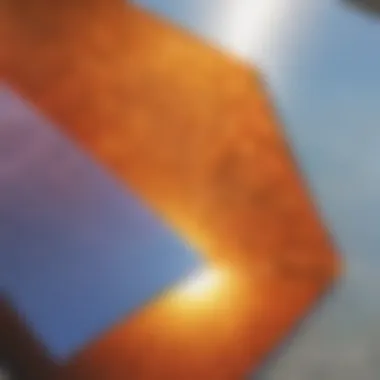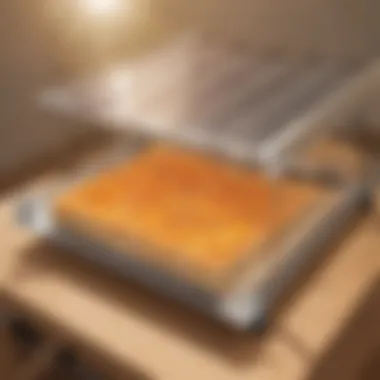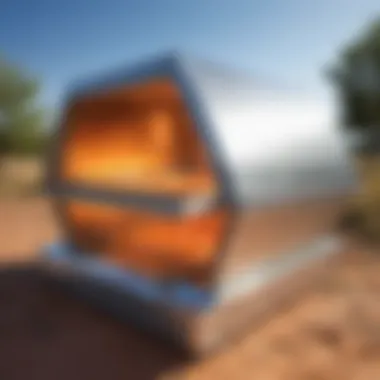Exploring Cutting-Edge Materials for Solar Oven Innovation


Science Fun Facts
Solar ovens work by utilizing reflective surfaces and insulating materials to harness the power of the sun for cooking. These innovative materials play a key role in increasing the efficiency and functionality of solar ovens, making them a sustainable energy solution.
Discover the Wonders of Science
Exploring the wonders of materials science, especially in the realm of solar ovens, can be an enlightening journey. By understanding the scientific concepts behind reflective surfaces and insulating materials, we can appreciate the ingenuity that goes into eco-friendly cooking methods.
Science Quiz Time
Let's test your knowledge about solar ovens and innovative materials! How do reflective surfaces help in cooking with a solar oven? A) By absorbing heat B) By reflecting sunlight C) By emitting radiation D) By conducting electricity
Science Experiment Showcase
For a fun and educational experiment, you can create your own mini solar oven using a shoebox, aluminum foil, and plastic wrap. Follow these steps: 1. Line the inside of the box with aluminum foil. 2. Cut a flap in the lid and cover it with plastic wrap. 3. Place food inside and close the flap. 4. Leave the box in direct sunlight and observe the cooking process. Remember to always have adult supervision when conducting science experiments to ensure safety at all times.
Reflective Surfaces
Reflective surfaces play a pivotal role in the construction of a solar oven. Their ability to efficiently reflect and focus sunlight onto the cooking chamber is essential for maximizing heat absorption and retention. In this article, we delve into the importance of utilizing high-quality reflective surfaces to enhance the overall performance of a solar oven.
Aluminum Foil
Properties and Benefits
When considering aluminum foil for a solar oven, its exceptional reflective properties and lightweight nature make it a standout choice. Aluminum foil boasts high reflectivity, allowing it to bounce off a significant amount of sunlight into the oven, aiding in heating food effectively. Additionally, its malleability and affordability make it a popular option for DIY solar oven enthusiasts. However, one drawback of aluminum foil is its relatively low durability compared to other materials, requiring careful handling during assembly and use.
Application in Solar Oven Construction
The application of aluminum foil in solar oven construction is straightforward yet crucial. By lining the interior walls of the oven with aluminum foil, users can maximize the reflection of sunlight onto the cooking vessel, ensuring even heating. This not only accelerates the cooking process but also contributes to energy efficiency. Despite its tendency to tear if mishandled, aluminum foil remains a practical choice for beginners seeking cost-effective solutions for their solar ovens.
Mylar Sheets
Reflectivity Factor
Mylar sheets are renowned for their exceptional reflectivity factor, making them a desirable material for solar oven construction. The high reflectivity of Mylar sheets ensures efficient sunlight capture, optimizing the oven's performance. Their ability to withstand prolonged exposure to sunlight without degradation further solidifies their position as a top choice for reflective surfaces in solar ovens.
Durability and Longevity
Aside from their impressive reflectivity, Mylar sheets exhibit remarkable durability and longevity. Unlike some other reflective materials that may deteriorate over time, Mylar sheets maintain their reflective properties, providing consistent performance throughout the life of the solar oven. Their resilience against environmental factors makes them a reliable option for sustainable cooking ventures that prioritize longevity and efficiency.


Insulating Materials
In the realm of constructing solar ovens, insulating materials stand as a cornerstone, pivotal for optimizing the oven's performance. Insulation plays a crucial role in retaining heat within the oven, ensuring efficient cooking process even in the absence of direct sunlight. The selection of the right insulating material is vital to prevent heat loss and maintain steady temperatures. By incorporating high-quality insulating materials, users can enhance the overall effectiveness of their solar ovens, making them energy-efficient and sustainable.
Fiberglass Insulation
Heat Retention Properties
Delving into the specifics, the heat retention properties of fiberglass insulation are paramount in the context of solar oven construction. Fiberglass exhibits exceptional heat retention capabilities, effectively trapping heat within the oven's chamber. This property is fundamental in sustaining high temperatures necessary for cooking food thoroughly and efficiently. The insulating prowess of fiberglass ensures minimal energy wastage, making it an ideal choice for eco-conscious individuals seeking to harness solar energy for culinary purposes.
Furthermore, fiberglass insulation's ability to withstand varying temperatures without deteriorating grants it durability and reliability in prolonged usage scenarios. This resilience contributes to the longevity of the solar oven, offering consistent insulation performance over time.
Installation Techniques
Turning to the installation techniques associated with fiberglass insulation, meticulous attention to detail is crucial for achieving optimal insulating effects. Properly installing fiberglass insulation involves ensuring a snug fit within the oven's structure, leaving no gaps or overlaps that could compromise its insulating properties. By tightly sealing the insulation layers, users can prevent heat leakage and maintain a stable cooking environment inside the oven.
Moreover, incorporating multiple layers of fiberglass insulation can enhance its insulating capacity, providing added protection against heat loss. Balancing the thickness and placement of insulation layers is key to maximizing heat retention and optimizing the solar oven's cooking performance.
Aerogel
Ultra-Light Insulation
Shifting focus to aerogel, its ultra-light insulation quality sets it apart as a valuable component in solar oven construction. Aerogel's lightweight nature contributes to the portability and maneuverability of the oven, making it easier to transport and set up for outdoor cooking activities.
The exceptional insulating properties of aerogel enable it to efficiently trap heat within the oven, promoting even heating and consistent cooking results. Despite its lightweight composition, aerogel is highly effective in maintaining stable temperatures within the oven, offering energy-efficient cooking solutions for eco-conscious individuals.
Thermal Efficiency
In terms of thermal efficiency, aerogel excels in minimizing heat transfer, thereby conserving energy and maximizing the oven's heating capabilities. The unique structure of aerogel restricts heat conduction, ensuring that the generated heat remains within the oven's confines for prolonged periods. This thermal efficiency not only facilitates faster cooking processes but also reduces the overall energy consumption of the solar oven.
Aerogel's superior thermal performance contributes to an eco-friendly cooking experience, aligning with sustainable practices and enhancing the feasibility of utilizing solar energy for culinary applications.
Heat Absorbing Elements
Heat absorbing elements are a pivotal component in the construction of a solar oven. These elements are essential as they capture and retain solar energy, enabling the oven to reach and maintain high temperatures for cooking. The inclusion of efficient heat absorbing elements directly influences the functionality and effectiveness of the solar oven. By selecting the appropriate materials for heat absorption, such as black paint and solar paint, individuals can enhance the overall performance of their solar cooking setup. Understanding the role of heat absorbing elements is crucial for maximizing the efficiency of a solar oven.
Black Paint
Absorption Capabilities
Discussing the absorption capabilities of black paint unveils its significance in solar oven construction. Black paint exhibits exceptional absorption properties, efficiently converting sunlight into heat energy. The deep hue of black paint enables it to absorb a wide spectrum of solar radiation, which is instrumental in heating the interior of the solar oven. This absorption quality ensures that maximum heat is retained within the oven, facilitating optimal cooking temperatures. The ability of black paint to absorb and retain heat successfully positions it as a preferred choice for enhancing the thermal performance of solar ovens.


Surface Preparation
Incorporating surface preparation techniques is vital for maximizing the efficacy of black paint in solar oven applications. Proper surface preparation involves ensuring that the painting surface is clean, smooth, and free of any contaminants that may hinder the paint's adhesion. Adequate priming and drying times are crucial for achieving a durable and long-lasting finish. The meticulous preparation of the surface ensures that the black paint adheres effectively, optimizing heat absorption and distribution within the solar oven. Attention to surface preparation significantly contributes to the overall performance and longevity of the black paint coating.
Solar Paint
Solar Absorption Efficiency
The solar absorption efficiency of solar paint plays a fundamental role in harnessing solar energy for cooking purposes. Solar paint is specifically formulated to maximize sunlight absorption, efficiently transforming it into heat. This heightened absorption efficiency allows solar paint to generate substantial heat within the oven, contributing to faster and more consistent cooking outcomes. The remarkable solar absorption capabilities of this specialized paint make it a valuable asset in enhancing the overall performance of a solar oven, ensuring efficient utilization of solar energy resources.
Environmental Impact
Considering the environmental impact of solar paint is essential when evaluating its suitability for solar oven construction. Solar paint is designed to be eco-friendly, typically formulated with low volatile organic compounds (VOCs) and non-toxic ingredients. Its minimal environmental footprint makes solar paint a sustainable choice for individuals seeking to reduce their carbon footprint. By using solar paint in solar oven construction, users can not only harness clean energy for cooking but also contribute to environmental preservation through the use of environmentally conscious materials.
Structural Components
In the realm of constructing a solar oven, the choice of structural components holds immense significance. Structural components, such as wood panels and cardboard boxes, provide the framework and support for the oven's functionality. Additionally, they contribute to the overall durability and stability of the solar oven, ensuring it can withstand varying environmental conditions and regular use.
Wood Panels:
- Sturdiness and Durability:
Wood panels are revered for their exceptional sturdiness and durability, making them a preferred choice for constructing solar ovens. The robust nature of wood panels ensures that the solar oven remains intact during operation, withstanding heat and potential stresses. This sturdiness guarantees a long lifespan for the oven, allowing for extended and reliable usage. The inherent durability of wood panels makes them an essential component in enhancing the overall resilience and performance of a solar oven.
- Weather Resistance:
Wood panels exhibit remarkable weather resistance, which is crucial for the sustained efficiency of a solar oven. Their ability to withstand varying climate conditions, including moisture and temperature fluctuations, ensures the structural integrity of the oven over time. This weather resistance feature prevents degradation of the wood panels, maintaining their quality and functionality in diverse outdoor settings. The weather-resistant properties of wood panels make them an ideal choice for ensuring the longevity and effectiveness of a solar oven.
Cardboard Boxes:
Cardboard boxes are another integral structural component in solar oven construction due to their unique qualities and benefits. Their recyclability and ease of assembly make them a sustainable and practical choice for building a solar oven.
- Recyclability:
The recyclability of cardboard boxes contributes significantly to the eco-friendly aspect of solar oven construction. Utilizing recyclable materials reduces environmental impact and promotes sustainability. Cardboard boxes can be repurposed, further enhancing their value in eco-conscious projects. Their recyclable nature aligns with the principles of renewable energy and responsible resource usage, making them an environmentally sound choice for solar oven construction.
- DIY Assembly Techniques:
Cardboard boxes offer the advantage of easy do-it-yourself (DIY) assembly techniques, simplifying the construction process for solar ovens. Their lightweight and customizable nature allow individuals to craft tailored oven designs with minimal effort. DIY assembly techniques involving cardboard boxes empower users to engage in hands-on construction, fostering a sense of accomplishment and creativity. The simplicity and versatility of cardboard boxes in solar oven assembly make them an accessible and user-friendly structural component.
Sealing and Adhesive Agents


In the realm of solar oven construction, the selection of sealing and adhesive agents holds paramount importance, acting as the binding force that ensures the structural integrity and heat efficiency of the oven. When delving into this realm, consideration for factors such as waterproofing properties and application techniques becomes crucial for optimal functionality. The choice of sealing and adhesive agents directly impacts the longevity and performance of the solar oven, making it a critical aspect that cannot be overlooked.
Silicone Sealant
Waterproofing Properties
Waterproofing properties in silicone sealants play a pivotal role in maintaining the integrity of the solar oven's structure by preventing moisture infiltration and ensuring durability. The impermeable nature of silicone sealant shields the solar oven from environmental elements, safeguarding it against corrosion and damage. This unique feature not only enhances the oven's lifespan but also maintains its heat efficiency by eliminating heat loss due to moisture penetration. Incorporating silicone sealant with superior waterproofing properties guarantees the sustainability and functionality of the solar oven in diverse environmental conditions, making it a preferred choice for constructing a reliable and long-lasting device.
Application Tips
When it comes to applying silicone sealant in solar oven construction, precision and technique are key factors to ensure a secure and effective seal. Emphasizing proper surface preparation before applying the sealant is essential to enhance adhesion and prevent leaks. Additionally, selecting the appropriate curing time and temperature for the silicone sealant optimizes its bonding strength and waterproofing capabilities. Following manufacturer recommendations and utilizing compatible tools for application can significantly improve the effectiveness of the silicone sealant, elevating the overall quality and reliability of the solar oven structure.
High-Temperature Adhesives
High-temperature adhesives serve as the backbone of solar oven assembly, providing structural reinforcement and heat resistance essential for the oven's operation. The heat resistance of these adhesives ensures that the oven can withstand high temperatures without compromising its structural integrity, enabling consistent performance during cooking processes. By exhibiting exceptional bonding strength, high-temperature adhesives create a durable and reliable bond between various components of the solar oven, enhancing its stability and longevity.
Heat Resistance
The heat resistance of high-temperature adhesives is a defining characteristic that enables them to withstand extreme temperatures encountered during solar cooking. This feature allows the adhesives to maintain their bonding properties without degradation, ensuring that the structural components remain securely joined even under intense heat exposure. The ability of high-temperature adhesives to resist thermal stress makes them an indispensable element in solar oven construction, providing the necessary durability to sustain long-term usage and operational efficiency.
Bonding Strength
Bonding strength is a key attribute of high-temperature adhesives that contributes to the structural integrity and performance of the solar oven. The strong bond created by these adhesives enhances the stability of the oven components, preventing disassembly or loosening due to thermal expansion and contraction. By promoting a robust connection between materials, high-temperature adhesives fortify the solar oven structure, ensuring its resilience against external factors and maintaining consistent functionality throughout its lifespan.
Finishing Touches
In the realm of constructing a solar oven, the Finishing Touches section carries immense significance. This segment acts as the final layer that not only enhances the aesthetics but also plays a critical role in the functionality and longevity of the solar oven. The materials used for finishing touches must exhibit properties that ensure transparency for efficient sunlight penetration while providing paramount protection against external elements like dust, debris, and weather fluctuations. Attention to detail in this section guarantees the overall effectiveness and durability of the solar oven, making it not just a cooking device, but a sustainable and resilient energy solution for eco-conscious individuals seeking self-sufficiency.
Glass Cover
Transparency Factors
Transparency in a solar oven's glass cover is pivotal for the entire cooking process. The glass's capacity to allow sunlight to pass through directly impacts the oven's efficiency in harnessing solar energy for cooking. High transparency ensures maximum solar energy absorption, subsequently leading to faster cooking times and increased temperature retention within the oven. By choosing a glass cover with optimal transparency factors, users can make the most of available sunlight and elevate the performance of their solar oven.
Protection from Elements
A paramount concern in solar oven construction is safeguarding the internal components from external elements. The glass cover's ability to shield the oven from dust, wind, rain, and other environmental factors is vital in preserving its functionality and prolonging its lifespan. Selecting a glass cover with exceptional protection capabilities ensures that the solar oven remains operational even in challenging outdoor conditions. Balancing transparency with durable protection from elements is key in optimizing the glass cover's performance within the context of solar cooking.
Reflective Tape
Enhanced Reflection
Reflective tape serves a crucial role in maximizing the efficiency of a solar oven by enhancing the reflection of sunlight onto the cooking chamber. The tape's reflective properties redirect and concentrate sunlight, increasing the overall heat within the oven for more efficient cooking. Choosing reflective tape designed for high reflectivity ensures that a greater amount of solar energy is harnessed, resulting in quicker cooking times and improved energy utilization. The use of enhanced reflection through reflective tape underscores the importance of small components in enhancing the overall functionality of a solar oven.
Aesthetic Appeal
While functionality is paramount in solar oven construction, the aesthetic appeal should not be overlooked. Reflective tape not only serves a functional purpose but also adds a pleasing visual element to the solar oven. The shiny surface of the tape provides a modern and sleek appearance to the oven, elevating its overall look. Integrating reflective tape for both its practical reflective qualities and aesthetic enhancement brings a balance between efficiency and visual appeal, showcasing the thoughtful design considerations in creating a truly innovative solar cooking experience.







